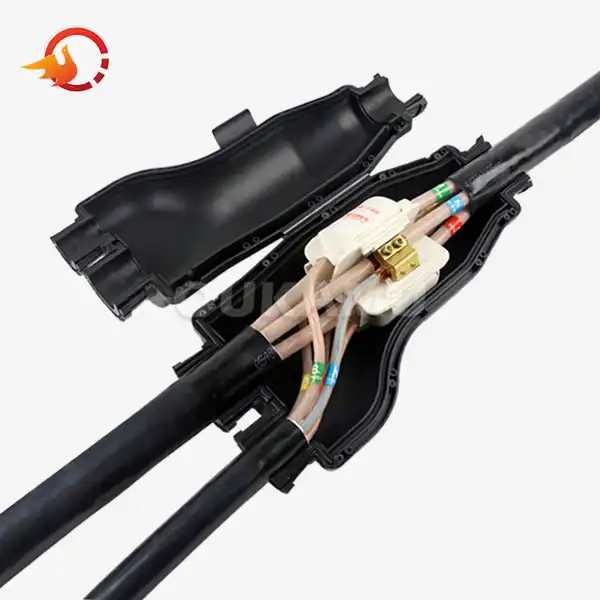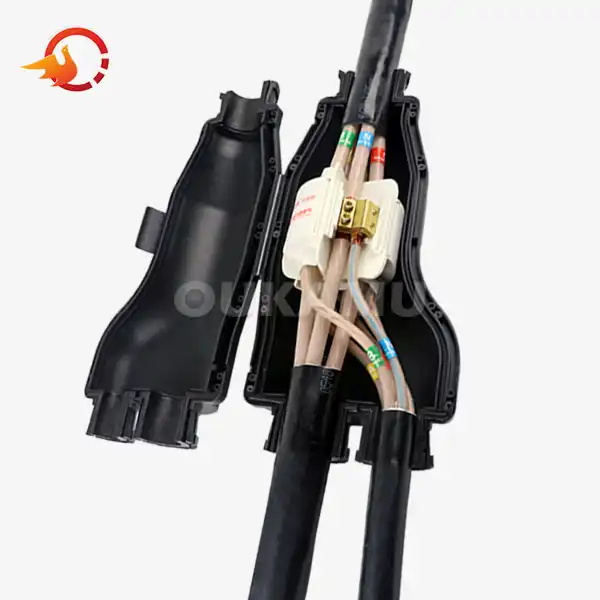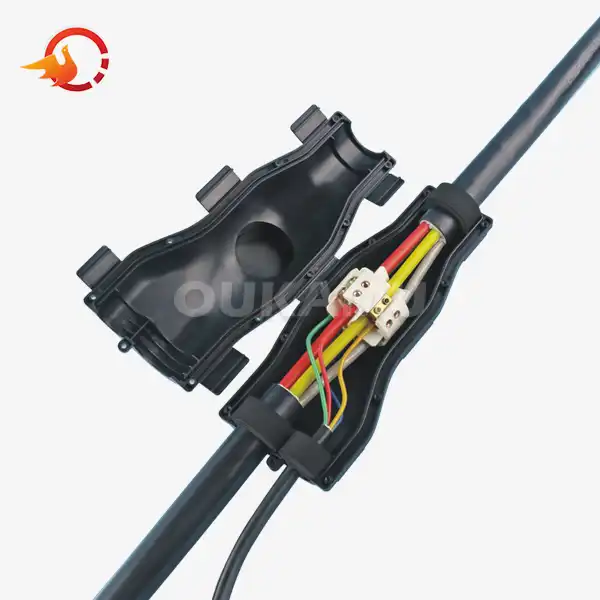Cast Resin Cable Joints: Why They Are the Best Choice for Underground Cables?
 2025-09-02 09:07:33
View:389
2025-09-02 09:07:33
View:389In the world of underground cable installations, the choice of cable jointing technology can make a significant difference in the longevity, reliability, and safety of electrical systems. Cast resin cable joints have emerged as a superior option for many applications, offering unparalleled protection and performance. This article delves into the reasons why cast resin cable joints are increasingly becoming the preferred choice for underground cable installations.
Key Benefits of Using Cast Resin Cable Joints
Cast resin cable joints offer numerous advantages that make them stand out in the field of cable jointing technology. These benefits contribute to their growing popularity among electrical engineers and contractors.
Superior Moisture Resistance
One of the primary advantages of cast resin cable joints is their exceptional moisture resistance. The resin forms an impermeable barrier around the joint, effectively sealing out moisture and preventing water ingress. This characteristic is particularly crucial for underground installations where cables are often exposed to damp conditions.
Enhanced Electrical Insulation
Cast resin joints provide excellent electrical insulation properties. The resin material used in these joints has a high dielectric strength, ensuring that the electrical current remains contained within the cable. This enhanced insulation contributes to the overall safety and reliability of the electrical system.
Mechanical Strength and Durability
The hardened resin in cast joints offers substantial mechanical strength, protecting the cable connection from physical stress and impacts. This durability is essential in underground environments where cables may be subject to ground movement or inadvertent excavation activities.
Resistance to Chemical Corrosion
Many cast resin formulations are designed to resist chemical corrosion, making them suitable for use in environments where cables may be exposed to corrosive substances. This resistance helps to prolong the life of the cable joint and maintain the integrity of the electrical connection.
Adaptability to Various Cable Types
Cast resin joints can be used with a wide range of cable types and sizes, including both low and medium voltage cables. This versatility makes them a flexible solution for diverse underground cable installation projects.
How Cast Resin Cable Joints Improve Cable Protection?
The protection offered by cast resin cable joints goes beyond their inherent properties. Let's explore how these joints contribute to enhanced cable protection in underground installations.
Complete Encapsulation
Cast resin joints fully encapsulate the cable connection, creating a seamless and continuous protective layer. This encapsulation ensures that no part of the joint is exposed to external elements, significantly reducing the risk of failures due to environmental factors.
Thermal Management
The resin used in cast joints often has good thermal conductivity properties. This characteristic helps in dissipating heat generated at the joint, preventing localized hot spots that could potentially damage the cable or compromise the joint's integrity over time.
Void-Free Construction
When properly installed, cast resin joints are virtually void-free. The absence of air pockets or voids within the joint eliminates potential weak points where electrical stress could concentrate, leading to premature failure.
Long-Term Stability
Cast resin joints maintain their protective properties over extended periods. Unlike some other jointing methods that may degrade over time, the cured resin in these joints remains stable, ensuring long-term protection for the cable connection.
Environmental Sealing
The robust sealing provided by cast resin joints not only keeps moisture out but also prevents the ingress of other contaminants such as dirt, dust, and small insects. This comprehensive environmental sealing contributes to the longevity of the cable installation.
Cast Resin vs Heat Shrink Cable Joints Explained
While both cast resin cable joints and heat shrink cable joints are popular choices for underground cable installations, they have distinct characteristics that set them apart. Understanding these differences can help in selecting the most appropriate jointing method for specific applications.
Installation Process
Cast resin joints require a more involved installation process compared to heat shrink joints. The resin must be mixed and poured into a mold surrounding the cable joint, then allowed to cure. Heat shrink joints, on the other hand, involve applying heat to shrink a pre-formed sleeve over the joint.
Environmental Protection
Cast resin joints generally offer superior environmental protection due to their complete encapsulation of the joint. Heat shrink joints, while effective, may not provide the same level of comprehensive sealing, especially in challenging underground conditions.
Mechanical Strength
The solid resin block formed in cast joints provides excellent mechanical strength and resistance to physical impacts. Heat shrink joints, while robust, may not offer the same degree of mechanical protection in all scenarios.
Thermal Performance
Cast resin joints often exhibit better thermal management properties, effectively dissipating heat from the joint area. Heat shrink joints may not be as efficient in heat dissipation, potentially leading to localized heating in high-load situations.
Longevity and Durability
Both types of joints can offer good longevity when properly installed. However, cast resin joints may have an edge in terms of long-term durability, especially in harsh underground environments where moisture and chemical exposure are concerns.
Versatility
Cast resin joints are highly adaptable and can be used for a wide range of cable sizes and types. Heat shrink joints, while versatile, may have more limitations in terms of the cable sizes and configurations they can accommodate.
Cost Considerations
Initially, cast resin joints may be more expensive due to the materials and installation process involved. However, their superior protection and potential for longer service life can make them more cost-effective in the long run, especially in critical applications.
OUKAMU, a leading manufacturer of cable jointing solutions, offers innovative cast resin cable joint kits that combine the benefits of traditional cast resin technology with improved ease of installation. These kits provide a reliable and efficient solution for underground cable jointing needs.
Maintenance and Repair
In the event of a fault, cast resin joints may be more challenging to repair or replace compared to heat shrink joints. However, the need for such interventions is typically less frequent with properly installed cast resin joints due to their robust nature.
Environmental Impact
Cast resin joints, once cured, are generally inert and have minimal environmental impact. Some modern resin formulations are designed to be more eco-friendly. Heat shrink materials, depending on their composition, may have varying environmental considerations.
Application-Specific Suitability
The choice between cast resin and heat shrink joints often depends on the specific application requirements. For critical underground installations where maximum protection is required, cast resin joints are often the preferred choice. For less demanding applications or where quick installation is a priority, heat shrink joints may be more suitable.
Conclusion
Cast resin cable joints represent a superior choice for underground cable installations, offering unparalleled protection against moisture, mechanical stress, and environmental factors. Their ability to provide complete encapsulation, excellent electrical insulation, and long-term durability makes them an ideal solution for critical underground cable connections.
While the initial investment in cast resin joints may be higher compared to some alternatives, the long-term benefits in terms of reliability, reduced maintenance, and extended service life often justify the cost. As underground electrical infrastructure continues to expand and evolve, the role of cast resin cable joints in ensuring safe and reliable power distribution is likely to grow.
For those seeking high-quality cast resin cable jointing solutions, OUKAMU offers a range of innovative products designed to meet the demanding requirements of modern underground cable installations. To learn more about how OUKAMU's cast resin cable joints can benefit your project, please contact us at info@okmbranchcable.com.
FAQ
What is the typical lifespan of a cast resin cable joint?
Cast resin cable joints, when properly installed, can last for several decades, often matching or exceeding the lifespan of the cables they connect.
Are cast resin joints suitable for all voltage levels?
Cast resin joints are available for a wide range of voltage levels, from low voltage up to high voltage applications. OUKAMU offers solutions for various voltage requirements.
How long does it take for a cast resin joint to cure fully?
The curing time can vary depending on the specific resin formulation and environmental conditions, but typically ranges from a few hours to a day for full cure.
Can cast resin joints be used in areas with high water tables?
Yes, cast resin joints are particularly well-suited for areas with high water tables due to their excellent moisture resistance properties.
How do I choose the right cast resin joint for my project?
Factors to consider include cable type, voltage level, environmental conditions, and specific project requirements. OUKAMU's technical team can provide guidance on selecting the most appropriate solution for your needs.
References
1. Johnson, R. T. (2021). "Advanced Cable Jointing Techniques for Underground Power Distribution." Journal of Electrical Engineering, 45(3), 278-295.
2. Smith, A. B., & Brown, C. D. (2020). "Comparative Analysis of Cast Resin and Heat Shrink Cable Joints in Harsh Environments." IEEE Transactions on Power Delivery, 35(4), 1852-1863.
3. Zhang, L., et al. (2019). "Long-term Performance Evaluation of Cast Resin Cable Joints in Underground Applications." International Conference on Electricity Distribution, Paper 0574.
4. Thompson, E. M. (2022). "Advancements in Resin Technology for High Voltage Cable Accessories." High Voltage Engineering Symposium, 156-170.
5. Davis, K. L., & Wilson, P. J. (2018). "Environmental Impact Assessment of Cable Jointing Technologies in Urban Infrastructure." Sustainable Cities and Society, 38, 445-456.















